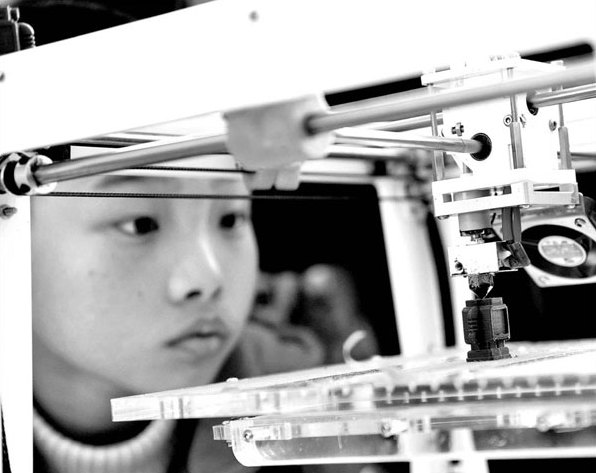|

A child watches as a model is produced by a 3D printer at a tech show in Hangzhou, Zhejiang province, in early April. Domestically developed 3D-printing techniques have been used in many fields, including bio-additive manufacturing, ceramic casting and laser sintering. Long Wei / For China Daily
|
Ever since US President Barack Obama gave a shout-out to 3D printing in his annual address, there has been a surge in interest worldwide in the emerging technology, and China is no exception.
China established its first industrial alliance in this field late last year and then a technological innovation center was founded this year to spur the creation of locally invented 3D-printing technologies.
To date, China's domestically developed 3D-printing techniques have been applied to many fields, including bio-additive manufacturing, ceramic casting and laser sintering, according to Xinhua News Agency.
"A 3D printer does not use ink to produce objects but rather materials that are deposited successively in thin layers," said Luo Jun, secretary-general of the China 3D Printing Technology Industrial Alliance, in an interview with Nanjing Daily in March.
Guided by a schematic in a computer, the 3D printer can create solid objects by laying down layers and then putting them together in a number of ways, he noted.
The emerging technology is known in industry as "additive" manufacturing. This contrasted with conventional means in which objects are made by cutting, drilling or shaping materials.
Other traditional production processes, such as pressing, molding and assembly, will also no longer be necessary for a 3D printer.
Compared to traditional manufacturing, additive manufacturing can reduce costs and risks. It also allows for mass customization.
However, Luo added it is "not as magical as people think and needs time to compete with mass-production technologies that have been honed for over a century".
While the devices are capable of creating a wide variety of objects based on designs, some of the products may not be usable or safe, he explained.
"We cannot drink water using a cup printed in 3D, because the currently used raw materials fail to meet the safety and environmental standards," he noted.
And, "airplanes, bicycles and guns produced in the same way are also just models with no functionality for now," he said.
In addition, the 3D industry also needs a mature business model in China, he added.
Moreover, as an emerging technology that marks a new era of manufacturing, it could also threaten brand owners, according to the Economist.
An article from the US newspaper reported that "good ideas can be copied even more rapidly with 3D printing, and it will be easier for imitators as well as innovators to get goods to market fast".
Some analysts in the media have raised concerns that intellectual property infringement may become more rampant because, in the future, the 3D printer will allow people to download products as they do digital music.
Others see it as a technological revolution like the advent of the personal computer.
haonan@chinadaily.com.cn
(China Daily 04/10/2013 page17)

